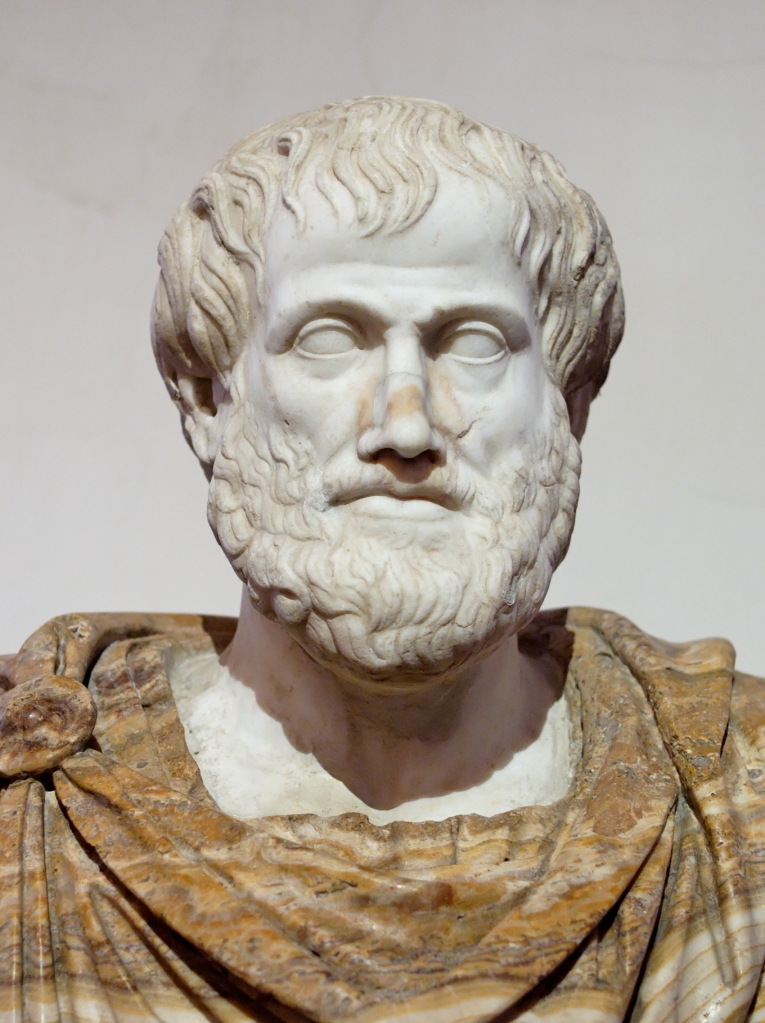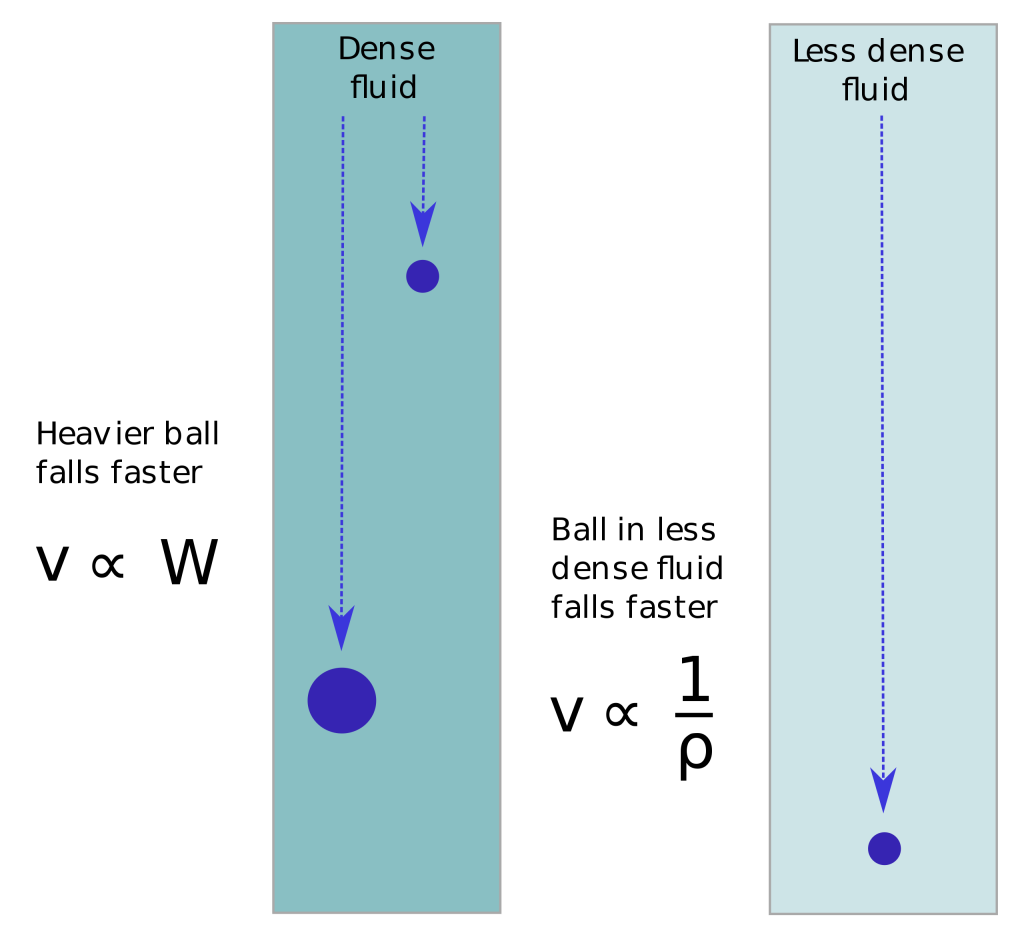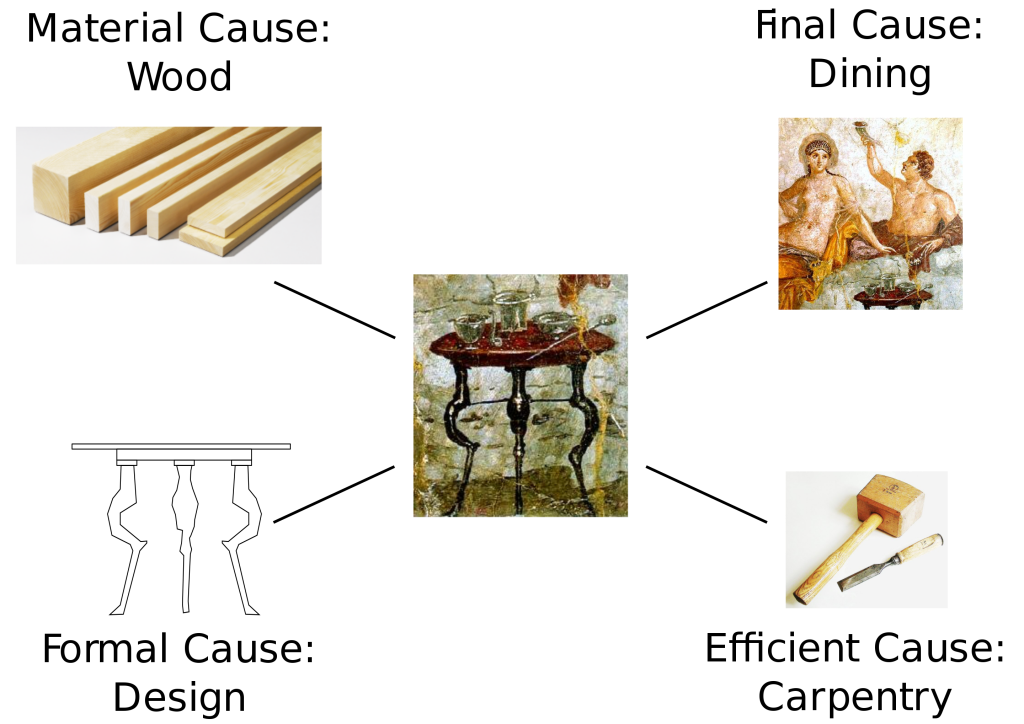There is very little doubt that Aristotle (384–§22 BCE) is the predominant figure in the narrative of the history of European science in the twenty-two centuries from 400 BCE to 1800 CE, and even after that he remains a central figure in the discourse. The general literature on Aristotle as a philosopher would fill a sizable library and the specific literature on his contributions to the history of science would fill a whole wing of that library. In this post, I will be limiting myself to a brief description of those aspects of his philosophy that had an impact on the history of physics.
As already explained in the first episode of this series, although Aristotle gave us the word physics in his book title τὰ φυσικά (ta physika), what he means with this is very different from what is meant by the modern use of the term physics. As this series is actually about the evolution of modern physics in the early modern period, I shall here only deal with various aspects of Aristotle’s philosophy that relate to that evolution and they are by no means confined to his τὰ φυσικά (ta physika).
Before I start, a brief biographical note on Aristotle. Born in Stagira in Northern Greece, the son of the prominent physician Nicomachus (fl. c. 375 BCE), who died whilst he was still young, he was brought up by a guardian. In his late teens he joined Plato’s Academy in Athens, where he remained until the death of Plato in 347/348 BCE. Around 343 BCE he left Athens at the request of Philip II of Macedon to become the tutor to his son Alexander (356–323 BCE), the future Alexander III of Macedon, better known as Alexander the Great. Around 340 BCE he returned to Athens and set up his own school of philosophy, the Lyceum. Having, for so long, been a pupil of Plato much of his philosophy was formed either by acceptance or rejection of Plato’s teaching.

One major area of acceptance, that would have consequences up to the seventeenth century, was his adoption of the cosmological and astronomical theories of Plato and Eudoxus, together with the four element theory, originally expounded by Empedocles. Aristotle took over the basic two sphere model from Plato. The cosmos is a sphere, which would become the sphere of the stars in astronomy, and the Earth is a sphere at its centre. Unlike Plato, Aristotle explains why the Earth is a sphere and also gives empirical evidence to show that it is truly a sphere. He argued that if something with gravitas falls then it falls towards the centre of the cosmos until it stops. The natural consequence of everything falling towards a centre from all direction is a sphere. This fall was not due to a force but to the tendency for objects to return to their natural or proper place. So, objects that have gravitas i.e., those predominantly consisting of earth or water, return to the Earth. Those with levitas, consisting predominantly of air or fire rise up into the atmosphere.
Of course, he has to explain why the celestial objects don’t fall to the Earth. Aristotle divides the cosmos into two zones, everything below the orbit of the Moon i.e., sublunar and everything above the orbit of the Moon i.e., supralunar. The sublunar zone consists of the four elements and is subject to change and corruption, whereas the supralunar zone consists of a fifth element, the aether or quintessence, which is unchanging and incorruptible. Natural motion in the supralunar zone is, once again following Plato and Empedocles, uniform circular motion.
One consequent of Aristotle’s insistence that the supralunar sphere was eternal and incorruptible was that he assigned both meteors and comets to the sublunar zone and considered them to be terrestrial phenomena. As I have documented in a series of posts my The emergence of modern astronomy–The debate on comets in the sixteenth century, Tycho Brahe and new astronomical data, The comets of 1618, Comets in Europe in the 1660s, Comets in Europe in the 1680s, Edmond Halley and the Comets–the unravelling of the true nature of comets played a significant role in the establishment of modern astronomy.
Unlike his predecessors, Aristotle provides empirical arguments to demonstrate that the Earth is actually a sphere, to quote James Hannam:
Aristotle concluded his discission by showing how the theory of the Globe explained observations that might seem otherwise inexplicable. In the first place, he said that when there is a lunar eclipse the shadow of the Earth on the Moon is always curved. This corroborates what he had already shown from his first principles. The umbra during a lunar eclipse follows from the shape of the Earth. If it is a ball, its shadow must always be an arc.
His second piece of empirical evidence is the way the visible stars change as we travel north or south. He noted that some stars, which are visible in Egypt and Cyprus, can’t be seen in the north. He is almost certainly referring to Eudoxus’ observations of Canopus. It is bright enough to be hard to miss in Egypt, albeit usually low in the sky. Its absence from view in Athens would have been obvious to anyone who had seen it further south. This is only explicable if the Earth is rounded, if it were a flat plane, everyone would see the same stars. Since it is spherical, it’s inevitable that our view of the heavens will change with latitude.[1]
Hannam closes his section on Aristotle with the following:
By any conventional standards he [Aristotle] knew the Earth was a sphere, and he was probably the first person who did. On that basis, he discovered the theory of the Globe. As we will see in the remainder of this book, everyone today who knows the Earth is round indirectly learnt it from Aristotle. This makes the Globe the greatest scientific achievement of antiquity. It’s only because we take it as obvious that we don’t give Aristotle the credit he deserves.[2]
For the planets Aristotle takes over the concentric or homocentric spheres of Eudoxus and Callippus but adds more spheres filling out the spaces between the planets making a complete set of spheres within spheres from the Moon to the stars. All motion within the heavens is driven by a sort of friction drive by the outer most sphere. This in turn is driven by an unmoved mover, a concept that appealed to the Church in the medieval period, who simply assumed that the unmoved mover was God. Although more scientific in his explanations than any of his predecessors, Aristotle can, at times, also be totally metaphysical. What motivates the unmoved mover? The spheres have souls, and it is the love of those souls for the unmoved mover that motivates it. The origin of the phrase, “love makes the world go round.”
As is generally well known, having defined fall as natural motion, Aristotle now goes on to elucidate his laws of fall, which, of course, everybody knows were wrong being first brilliantly corrected by Galileo in the seventeenth century. Firstly, Aristotle’s laws of fall are not as wrong as people think, and secondly, they were, as we shall see in later episodes, challenged and corrected much earlier than Galileo.
Aristotle’s laws of fall are actually based on simple everyday empirical observation. If I drop a lead ball from an oak tree it evidently falls to the ground faster than an acorn that I dislodge whilst dropping the ball. In real life not all objects fall at the same speed. It is only in a vacuum that this is the case. People tend to ignore the all-important “vacuum” when praising Galileo’s enthronement of Aristotle’s laws of fall. Naturally if I drop a two lead balls of different weights, they do fall at approximately the same speed but even here the heavier ball will hit the ground a split second earlier than the lighter one.
Aristotle argued that the rate of fall was directly proportional to the weight of the falling object and indirectly proportional to the resistance of the medium through which it falls.

This is a good first approximation for objects on the Earth falling through air or water. Having established this Aristotle then argued that the void (a vacuum) could not exist because in the void a falling object would accelerate to infinity and that was an absurdity. Interestingly he also argues that in a vacuum all objects would fall at the same speed, an absurdity! Galileo anyone? It is quite common to express his laws of fall either symbolically or even mathematically, but Aristotle never did either.
As already said, although Aristotle gave us the word physics, he uses it in a very different way. For Aristotle physics is the study of natural things, which he sees as the study of the general principles of change. Change is for Aristotle universal, plants grow and then die, there is quantitative change with respect to size and number and so forth. Most important from our point of view is that he considers motion to be change of place.
In Aristotle’s theories of motion, having dealt with natural motion he now had to define and deal with unnatural motion. Of course, there was only natural motion in the uncorruptible supralunar area. On Earth beyond natural motion there was voluntary motion and unnatural motion. Voluntary motion is such as animals moving and need not concern us here. Unnatural motion requires a cause, and it is here that Aristotle’s whole theory of motion ran into difficulties.
If I have a horse and cart or I push a wheelbarrow, then the cart only moves if the horse pulls and the wheelbarrow only moves if I push. If the horse stops pulling or if I stop pushing then the motion stops, no real problems here, although it is difficult to fit this type of motion into the laws of motion that applies to the falling object. Aristotle’s real problems start with projectile motion. If I fire an arrow with a bow or throw a ball, why does the arrow after it has left the bow string or the ball after it has left my hand continue to fly through the air? There is now apparently nothing propelling the arrow or ball. Aristotle’s escape from this impasse is, to say the least, dodgy. He argued that the air displaced by the flying object rushed around to the back and pushed it further along its course. This weak point in his theory was exploited comparatively early by his critics, i.e., long before the seventeenth century.
Aristotle rejected atomism arguing there was no limit to how far one could divide something, so no smallest particles, atoms. His own theory of matter was that there is primal material. Objects consist of two things material and form. This is important because it plays a role in his fourfold theory of cause that dominated his whole philosophy of nature.
According to Aristotle everything in nature has four causes:
- The Material Cause: The material out of which it is composed.
- The Formal Cause: The pattern or form that makes the material into a particular type of thing.
- The Efficient Cause: In general that which brings an object about
- The Final Cause: The purpose for the existence of the object in question
The four causes also apply to abstract concepts such as motion, each motion has a material, a formal, an efficient, and a final cause.

Today, we regard the final cause, for which the technical term is teleology, as bizarre. Since at least the nineteenth century it is not thought that most things have an intrinsic purpose for their existence, they just exist. However, in the Middle Ages, the high point of Aristotelian thought in science, it would have chimed with Christian thought, “everything has a place in God’s great plan.
Introducing Aristotle’s four causes takes us along to, perhaps Aristotle’s greatest contribution to the development of science his methodology and his epistemology, i.e., his theory of knowledge. In six works, collectively known as the Organon, he laid out the earliest known introduction to formal logic. How do I argue correctly, so that I transport truth from my premises to my conclusions. Our understanding of logic and the logic that we use have evolved since Aristotle, but logic still lies at the heart of all formal scientific proofs. Stealing from Wikipedia the six Aristotelian works on logic are:
- The Categories (Latin: Categoriae) introduces Aristotle’s 10-fold classification of that which exists: substance, quantity, quality, relation, place, time, situation, condition, action, and passion.
- On Interpretation (Latin: De Interpretatione) introduces Aristotle’s conception of proposition and judgement, and the various relations between affirmative, negative, universal, and particular propositions.
- The Prior Analytics (Latin: Analytica Priora) introduces his syllogistic method argues for its correctness, and discusses inductive inference.
- The Posterior Analytics (Latin: Analytica Posteriora) deals with definition, demonstration, inductive reasoning, and scientific knowledge.
- The Topics (Latin: Topica) treats issues in constructing valid arguments, and inference that is probable, rather than certain. It is in this treatise that Aristotle mentions the Predicables, later discussed by Porphy and the scholastic logicians.
- The On Sophistical Refutations (Latin: De Sophisticis Elenchis) gives a treatment of logical fallacies, and provides a key link to Aristotle’s tractate on rhetoric.
Although not really clearly spelt out, Aristotle propagated an axiomatic deductive system for securing knowledge. Starting from self-evident premises that require no proof one uses a chain of deductive logic until one arrives at empirically observed facts. Although we would regard his premise that the Earth is a sphere because all falling objects fall to the centre of the universe as self-evident, this is the form of argument, sketched above, he uses to demonstrate that the Earth is really a sphere.
It is important to note, for the evolution of scientific thought in Europe throughout the centuries after Aristotle, that when applied to nature he didn’t regard mathematical proofs as valid. He argued that the objects of mathematics were not natural and so could not be applied to nature. He did however allow mathematics in what were termed the mixed sciences, astronomy, statics, and optics. For Aristotle mathematical astronomy merely delivered empirical information on the position of the celestial bodies. Their true nature was, however, delivered by non-mathematical cosmology. I shall deal with statics and optics separately.
In recent times, various voices have claimed that the adherence to Aristotle’s vision of science hindered the evolution of the discipline. It is a similar claim to that of the gnu atheists that Christianity blocked the evolution of science. In the case of Aristotle, I think we should bear in mind that in antiquity his popularity waned fairly quickly after his death, and he was superceded by the Stoics and then the Epicureans as the flavour of the century in philosophy and although this included the period of the greatest Greek mathematicians Archimedes (c. 287–c.212 BCE) Apollonius of Perga (c. 240–c. 190 BCE), who both made significant advances in both pure and applied mathematics, it cannot be said that the world advanced significantly towards modern science.
[1] James Hannam, The Globe: How the Earth Became Round, Reaktion Books, London, 2023 p. 93
[2] Hannam p. 95